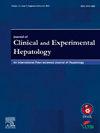Impact of Resistance Associated Substitutions and Predictors of Treatment Failure Following Direct-acting Antiviral Therapy in a Viral Hepatitis C Elimination Cohort
IF 3.3
Q2 GASTROENTEROLOGY & HEPATOLOGY
Journal of Clinical and Experimental Hepatology
Pub Date : 2025-05-28
DOI:10.1016/j.jceh.2025.102601
引用次数: 0
Abstract
Background
The National Viral Hepatitis Control Program (NVHCP) has a cure rate of 91.6% when using direct-acting antivirals (DAAs)–sofosbuvir with an NS5A inhibitor (ledipasvir, daclatasvir or velpatasvir) ± ribavirin in the Punjab hub-and-spoke model of hepatitis C virus (HCV) elimination.
Methods
We collected the clinical and virological data for the ∼8.4% treatment failure cases. Sanger nucleotide sequencing was performed to identify the resistance-associated substitutions (RAS) following treatment failure. We ascertained the clinical and virological predictors of treatment failure under the NVHCP.
Results
Between April 2019 and December 2023, 50865 patients with HCV were treated; median age 41.6 years, 65% men, 85.8% without cirrhosis, 8.5% treatment experienced, median viral load (x106) of 4.1 (2.9–7.8),71.3% genotype (GT)-3, with cure rate of 89.5%. On multivariable analysis, age (aOR 1.5, 95% CI: 1.3–1.9, P = 0.021), presence of cirrhosis (aOR1.8, 95% CI: 1.3–2.5, P < 0.001), and poor drug compliance (aOR 0.3, 95% CI: 0.2–0.6, P < 0.001) predicted treatment failure. We enrolled a difficult-to-treat group of 640 persons for virological testing, aged 39.2 ± 15.1 years, median HCV viral load (x106) of 1.98 (1.5–2.4). Of these, 56.6% were treatment-experienced, 11.1% were prior defaulters, with predominant GT3 (73.3%) and GT1 (18.7%) with coinfection rates of 3.8% and 4.4% for hepatitis B virus (HBV) and human immunodeficiency virus (HIV), respectively. Presumed modes of transmission in this subgroup were unsafe injections (57%), and injection drug use (32.8%). A total of 243 patient samples underwent RAS testing, with 45 patients having detectable variants, and finally 31 RAS mutations were detected in the NS5A gene, with no clinically significant resistance observed in the NS5B gene. In GT-3, the RAS observed were A30K, L31 M/R, A62S, A62T, and Y93H. In GT-1, the RAS observed were M28A, H58P, G30 H/R, H58D, and Y93K. Among these Y93K, L30R, G30 H/R confer resistance to velpatasvir; such patients received retreatment with voxilaprevir-containing regimens.
Conclusion
Patient factors like compliance and the presence of cirrhosis predicted treatment failures. RAS do not appear to be a primary factor for treatment failure in a public health setting.
Clinical trials gov number
NCT03488485 available from https://clinicaltrials.gov/study/NCT03488485.
在病毒性丙型肝炎消除队列中,直接作用抗病毒治疗后耐药性相关替代的影响和治疗失败的预测因素
国家病毒性肝炎控制规划(NVHCP)在旁遮普省消除丙型肝炎病毒(HCV)的中心辐射型模型中使用直接作用抗病毒药物(DAAs) -sofosbuvir联合NS5A抑制剂(ledipasvir、daclatasvir或velpatasvir)±利巴韦林时,治愈率为91.6%。方法收集治疗失败病例的临床和病毒学资料。在治疗失败后进行Sanger核苷酸测序以鉴定耐药相关替代(RAS)。我们确定了NVHCP治疗失败的临床和病毒学预测因素。结果2019年4月至2023年12月,共治疗了50865例HCV患者;中位年龄41.6岁,男性占65%,无肝硬化占85.8%,有治疗经历者占8.5%,中位病毒载量(x106) 4.1(2.9-7.8),基因型(GT)-3占71.3%,治愈率89.5%。在多变量分析中,年龄(aOR 1.5, 95% CI: 1.3-1.9, P = 0.021)、是否存在肝硬化(aOR1.8, 95% CI: 1.3-2.5, P <;0.001),药物依从性差(aOR 0.3, 95% CI: 0.2-0.6, P <;0.001)预测治疗失败。我们招募了一个难以治疗的640人进行病毒学检测,年龄39.2±15.1岁,中位HCV病毒载量(x106)为1.98(1.5-2.4)。其中,56.6%的患者接受过治疗,11.1%的患者既往未接受治疗,主要为GT3(73.3%)和GT1(18.7%),乙型肝炎病毒(HBV)和人类免疫缺陷病毒(HIV)的合并感染率分别为3.8%和4.4%。该亚组中推测的传播方式为不安全注射(57%)和注射吸毒(32.8%)。共有243例患者样本进行了RAS检测,其中45例检测到变异,最终在NS5A基因中检测到31例RAS突变,NS5B基因未见临床显著耐药。在GT-3中,观察到的RAS为A30K、L31 M/R、A62S、A62T和Y93H。在GT-1中,观察到的RAS有M28A、H58P、G30 H/R、H58D和Y93K。其中Y93K、L30R、g30h /R赋予维帕他韦耐药;这些患者接受含沃西雷韦方案的再治疗。结论患者依从性、肝硬化等因素可预测治疗失败。在公共卫生环境中,RAS似乎不是治疗失败的主要因素。临床试验gov编号bernct03488485可从https://clinicaltrials.gov/study/NCT03488485获得。
本文章由计算机程序翻译,如有差异,请以英文原文为准。
求助全文
约1分钟内获得全文
求助全文
来源期刊

Journal of Clinical and Experimental Hepatology
GASTROENTEROLOGY & HEPATOLOGY-
CiteScore
4.90
自引率
16.70%
发文量
537
审稿时长
64 days
 求助内容:
求助内容: 应助结果提醒方式:
应助结果提醒方式:


